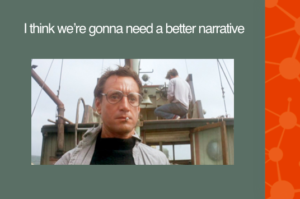Stories change brains and behavior. That’s the good news. And the bad news too.
Stories change our brains and behavior, for better and for worse. Some stories make us weak; some make us strong. And in the long run, success starts with the story we tell. So we have to choose our stories wisely.
Yet, storytelling is a competitive sport, and less than 10 percent of stories even make it through the brain’s spam filter.
We’ve all felt the pain of an important story that doesn’t break through, or a false story that won’t go away. The challenge before us: how can we build a better narrative? That’s the mission of Castle & Spark.

We’ve all felt the frustration of an important message that just won’t break through. Or a false perception that won’t go away. That’s the problem we set out to fix.
.
Our work distills twenty five years of science into three kinds of stories that are easy to learn and apply. It harnesses the emotional impact of a good story to the intellectual horsepower of cutting edge cognitive science. I call it cognitive storytelling.
Cognitive storytelling is the art and science of building narratives that feel better, do better, and create change for the better.
Joseph Campbell, and the scholars and storytellers who followed him, have much to teach about the classical structure of a great story. The Hero and the Shadow, the journey into the unknown, the search for a mentor; these are archetypes as ancient as our species.
But science has advanced since Joseph Campbell created the monomyth in 1949. Cognitive psychology, mindset science, behavioral economics, modern neuroscience — none of those things existed when Campbell did his work. He drew on the psychology of Freud and Jung, but since then science has advanced tremendously.
Cognitive science has given us insight we never possessed before about how narratives work in the brain. And the more we learn, the more we see how powerful stories really are. Behavioral economics and neuroscience has given us precise new tools and insights to rewire our brains and rewrite our narratives.
But all the science in the world doesn’t work if we can’t translate it into a narrative people can use.
People don’t learn through scientific principles. We learn through stories. Stories change our brains. Stories change our lives. Through the right story, we can transform others, and we can be transformed ourselves.
And the SPARK narrative model is an instrument of transformation. To pair the world’s most powerful archetypes with cutting-edge cognitive science.
The SPARK narrative model© is built on decades of research in cognitive psychology, behavioral economics, neuroscience and enterprise performance. Our model offers a new way of building your message platform: a story that will promise transformation, fuel performance, and prove resilient in the face of life’s inevitable setbacks.
Kenneth Burke said that “Stories are equipment for living.” They are more than that. Narratives are the nourishment we need to survive. But first you need to tell the right story. And once you change the narrative, everything changes.
stories are survival instruments
Joseph Campbell and the US Army War College
 Right after World War II, the US Army War College conducted a worldwide investigation into how the military could provide leadership in this new world order. They came up with the concept of VUCA, the idea that the new world is “Variable, Uncertain, Complex and Ambiguous,” and said that what people need, more than anything else, is leaders who can help them make sense of this uncertain world.
Right after World War II, the US Army War College conducted a worldwide investigation into how the military could provide leadership in this new world order. They came up with the concept of VUCA, the idea that the new world is “Variable, Uncertain, Complex and Ambiguous,” and said that what people need, more than anything else, is leaders who can help them make sense of this uncertain world.
Joseph Campbell calls this same idea the “Hero’s Journey” — the notion that our lives are a series of journeys in which we go into the unknown, face obstacles, and emerge transformed.
Whether you prefer to follow Joseph Campbell or the War College, the idea is the same. We’re always looking for a good story, not just because we like to hear it, but because stories are survival instruments that help us confront and successfully navigate the unknown. That’s why leadership and storytelling have always been so inextricably connected, why Jesus and the Buddha speak in narratives, and why the most effective Presidents have always been the best storytellers. We need narrative to survive as much as we need food. And the best narratives will always deliver the strongest results.
But that doesn’t mean that every story works. Like we said, storytelling is a competitive sport. And what we have learned in the last decade or so is not just why stories work, but how to build the right story.
